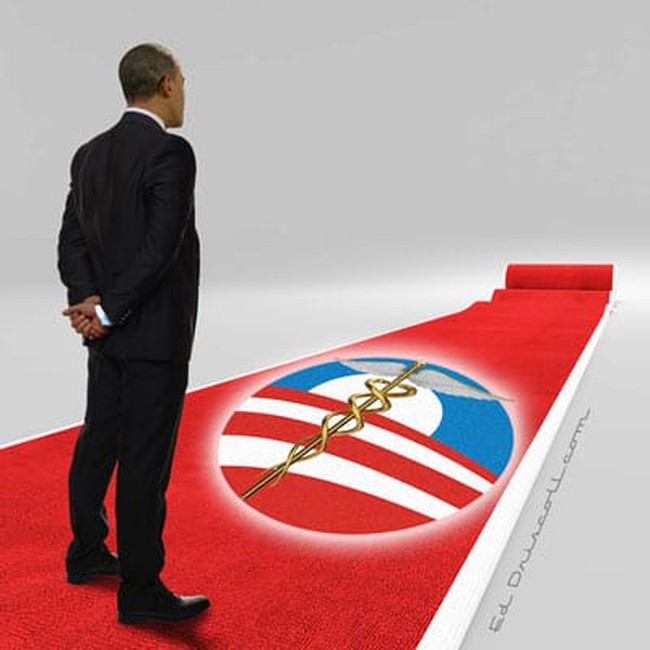This is the second part in a series of articles on the rollout of Obamacare and how the law will change our health care system. Each week, we will publish two articles — one on the changes in medicine and medical care and one on changes in the insurance industry. We hope this series of articles will help you make better decisions when it comes to your health care and how you buy insurance.
The first article of this series described how the ObamaCare law is fueling the rise of government-controlled Big Medicine. This second article will take a closer look at how Big Medicine will control how what medical care patients can receive.
During the ObamaCare debates of 2009 and 2010, the debate centered around the twin goals of achieving “coverage” for Americans and of cost control — often phrased in terms of “bending the cost curve” down.
Normally, the government doesn’t really care how much Americans spend in aggregate on privately purchased items such as smart phones or concert tickets. Bureaucrats don’t worry about “cost control” in that sense.
However, health care is different. Health care costs currently account for almost 25% of the federal budget. Furthermore, “in just a decade, health care will consume nearly one in three federal dollars, pressuring government spending in other areas, such as infrastructure and the military.” Under ObamaCare, government is expected to account for 66% of all health spending, which makes it their concern.
But to control health costs, the government must control the behavior of those providing medical services — namely doctors and hospitals. I wish to focus on two controls in particular: “bundled payments” and “pay for performance.”
With “bundled payments,” hospitals and physicians receive a fixed fee to take care of Medicare patients’ conditions (e.g., a stroke or a heart attack) regardless of how much the care actually costs. If they can treat the patient for less than the bundled payment, they keep the excess. If their costs exceed the payment, they must absorb the loss.
With Medicare “pay for performance” (or “P4P”), the government withholds a percentage of normal Medicare payments to doctors and hospitals. It then pays out that money at the end of year if doctors achieve certain “quality” benchmarks (e.g., percentage of heart attack patients who received a certain drug, or percentage of suspected pneumonia patients who received certain blood tests).
(Because providers can only earn up to the original full payment, it should probably be called “non-pay for non-performance.”)
These methods are typically justified as improving “value” and “quality.” But they can also compromise patient care.
Consider “bundled payments.” In theory, the fixed payment is supposed to encourage “efficient” and “integrated” care. But in practice, they create perverse incentives for doctors to skimp on care, especially for the sickest patients.
A hospital administrator might ask a doctor, “Do you really need to take Mrs. Smith to surgery now for her heart problems? Or can she get by with only medications for a little while longer? And does she really need the high-end antibiotic that kills 99% of bacteria? Or can we get away with the cheaper drug that works 85% of the time? We’ve already burned through her fee for this admission, so anything else you do for her comes out of our pockets!”
(Physicians employed directly by hospitals will have an especially hard time resisting such pressures from administrators with the power to terminate their employment contracts.)
Similarly, “pay for performance” (P4P) incentives can compromise patient care by pressuring hospitals and doctors to place the government’s priorities ahead of patients’ actual clinical needs. We see a similar phenomenon when government schools are rewarded for student performance on standardized tests. Schools can be tempted to “teach for the test” rather than teaching what’s actually important for their students’ future academic and life success.
For example one government P4P metric is, “Percent of patients who had their antibiotics stopped within 24 hours after surgery ended.” For most surgery patients this is appropriate care. But surgeon Jeffrey Parks has described numerous bureaucratic headaches when his patients had specific medical problems that required a longer course of antibiotics and he needed to order medications for longer than the approved protocols.
Another P4P metric is, “Percent of surgical patients that received the correct kind of antibiotic.” However, Dr. David Gelber has described a situation when the protocol mandated an additional antibiotic he considered medically unnecessary for his patient’s specific operation.
Dr. Gelber was informed that if he didn’t follow the guidelines, the nursing staff would “get in trouble.” He reluctantly allowed them to administer the unnecessary medication, hoping it wouldn’t cause any adverse side effects. (It didn’t.)
In Dr. Gelber’s words,
Administering unnecessary antibiotics opens the door to potential side effects, some of which can occur after only a single dose. Disruption of normal, symbiotic bacteria by the administration of antibiotics can cause transient diarrhea or severe colitis, while allergic reactions are always unpredictable. …
Yet, here is an example of the SCIP [Surgical Care Improvement Program] administrators, who are not physicians, insisting on inappropriate antibiotics. Every surgeon learns, as part of their training, the proper way to administer prophylactic antibiotics, which medication to order for which procedure and for what duration. But, surgeons also understand that there are often situations where deviation from the usual regimen is not only allowable, it may be vital and life saving.
These examples illustrate a larger trend of attempting to control costs through standardized practice protocols.
Standardized guidelines and protocols aren’t always bad. Dr. Atul Gawande has written a now-classic essay on how well-devised checklists and practice guidelines can protect patient safety and improve clinical outcomes. When someone comes into the ER with chest pain and a suspected myocardial infarct (“heart attack”), it’s appropriate to utilize checklists to ensure the patient receives his or her oxygen, an IV, EKG, appropriate blood tests, etc. Protocols and checklists can serve as a vital procedural “safety net” to protect against sloppiness or human error — like an astronaut running through a standard safety checklist before liftoff.
Standardized protocols can be an important adjunct to clinical judgment, but they cannot replace human judgment. Clinical protocols may be fine for 95% of patients, 95% of the time. But not all patients will fit the standard guidelines; there will always be outliers. The art of medicine consists in tailoring general guidelines to the individual patients as necessary, which requires the independent judgment of the skilled physician. This independent judgment is the heart of good medical practice.
As a patient, you want your doctor to be rewarded for using his expertise on your behalf, not punished for it. You don’t want to be the patient receiving too few (or too many) antibiotics because a bureaucrat is overriding your doctor’s best judgment.
As a physician, this is one of my biggest concerns about Big Medicine — namely government intrusion into the doctor-patient relationship. Your doctor may have to choose between following government guidelines vs. doing what’s medically right for you as an individual. Will he still uphold his Hippocratic Oath, even though it may jeopardize his compliance statistics? Or will he meekly comply with the guidelines? You’d better hope he’ll still be willing to make the right choice.
Finally, “bundled payments” and “pay for performance” likely won’t be the end of government controls over health spending. The state of Massachusetts has already enacted into law “global caps” on aggregate health spending (public and private). The exact enforcement mechanisms are still to be determined, but this will inevitably mean more restrictions on who can receive what medical care. In the New England Journal of Medicine, several prominent ObamaCare supporters have called for a similar national-level binding “global spending target for both public and private payers.” If current cost control measures fail, this will likely be the next phase of Big Medicine.
Next article: The role of electronic medical records and Big Data in Big Medicine.










Join the conversation as a VIP Member